Geotimes

Geomedia
Geotimes.org offers
each month's book reviews, list of new books, book ordering information and new
maps.
Check out this month's On
the Web links, your connection to earth science friendly Web sites. The
popular Geomedia feature now available by topic.
Book Reviews:
On the Shelf for the Holidays
Books for the western traveler
Maps:
New maps from the U.S. Geological Survey
On
the Shelf for the Holidays
If you can’t quite figure out what to get the geologist on your holiday
gift list, try one of our book picks below. Or if you’re the geologist,
and have long been looking for a gift to draw a non-geologist into the world
you know so well, these books might just be the perfect solution.
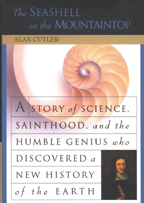 |
The Seashell on the Mountaintop: A Story
of Science, Sainthood, and the Humble Genius Who Discovered a New History
of the Earth, by Alan Cutler.
Dutton (Penguin Group), 2003. ISBN 0 525 94708 6. Hardcover: $23.95.
Nicolai Steno started out in medicine in Denmark in the 1650s, mid-Enlightenment.
He ended up becoming, as Alan Cutler writes in his biography, geology’s
very own saint (the scientist was beautified 1988), an anatomist of the
Earth who may have discovered more had he not entered the priesthood.
Cutler argues Steno changed the world of geology by creating a new history
of Earth at a time when science and religion were intricately entwined
and biblical sources established the age of the world. The biography is
solidly in the tradition of Dava Sobel’s Longitude and Simon
Winchester’s Map that Changed the World, and Cutler’s
prose constructs a readable web of history and entertaining ideas about
science and religion.
|
|
Children of the Stars,
by Daniel R. Altschuler.
Cambridge University Press, 2002. ISBN 0 521 81212 7. Hardcover, $28.00.
Daniel Altschuler weaves an engaging story of us, the “children
of the stars,” born out of celestial events 15 billion years ago.
The book presents not only the evolution of Earth and life, but also the
evolution of scientific thought over the centuries — the beautiful
and sometimes painful marriage of physics, chemistry, paleontology and
biology that has crafted our understanding of the universe and earth science.
Altschuler’s heart clearly lies in the world of astronomy, but he
gives fair time and simple explanation to all Earth-shaping processes.
The book is complete with beautiful images of distant galaxies, pulsars
and other cosmic wonders, entertaining cartoons, and useful diagrams to
explain key scientific concepts. The book could do without some cutesy
lines used to break up more technical sections, but on the whole, it does
not disappoint: Open it and you will not be able to close it.
|
 |
 |
A Celebration of the World’s Barrier
Islands, by Orrin H. Pilkey
with Original Batiks by Mary Edna Fraser. Columbia University Press, 2003.
ISBN 0 231 11970 4. Hardcover, $44.95.
Featuring batiks by an artist who shares a passion for barrier islands
with the geologist who wrote the text, this hefty book provides a vivid
profile of many of the world’s dynamic coastlines. Orrin Pilkey begins
with the role natural hazards play and moves on to discuss the many threats
humans pose to barrier islands worldwide — from the Gulf of Mexico
to Iceland, Russia, Vietnam and Venice. This scientifically sound survey
of barrier islands is an asset for geologists and students alike —
and also provides a layperson an interesting read. Spectacular aerial
photographs, digital maps and descriptive illustrations make this a stunning
coffee table book.
|
|
Water Wars: Drought, Flood, Folly, and
the Politics of Thirst, by
Diane Raines Ward.
Riverhead Books (Berkley Publishing Group, a division of Penguin Group),
2002.
ISBN 1 57322 995 4. First paperback edition, $14.00. Hardcover, $24.95.
Violent wars have been and will be fought over water, but the water wars
that Diane Raines Ward takes her reader around the world to visit are
quieter, though no less grand in conflict. These battles to ensure a source
of water for drinking, agriculture, and other human needs rage across
the planet — from India, with its droughts and water-borne disease
(where Ward works with her husband on conservation issues), to Holland
and its floodgates, to Wyoming and its desiccated farms. The wars Ward
describes, impending or already passed, encompass politics and engineering.
Though her bias may be environmental, Ward treats her subject both personally
and as an objective reporter, with a decade of research stocking her pen.
|
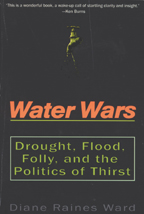 |
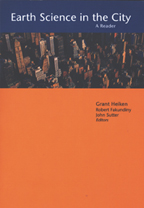 |
Earth Science in the City: A Reader,
edited by Grant Heiken, Robert Fakundiny, John Sutter.
American Geophysical Union, 2003. ISBN 0 087590 299 5. Hardcover, $57.00.
Although the image of geology is tied to remote field areas and rugged
mountains, the greatest challenges that our science can help address lie
where people live. With the tremendous growth of urban populations, resource
needs and environmental impacts are soaring as is the vulnerability of
urban dwellers to natural hazards. This book, which sprang from a session
convened by the editors at an AGU meeting in 2000, includes chapters focusing
on a variety of natural hazards confronting urban centers, the contributions
made by engineering geology, hydrology and remote sensing, and the challenge
of integrating geoscience information into urban planning. Several chapters
provide case studies from cities in the United States and abroad.
|
|
Coal: A Human History,
by Barbara Freese.
Perseus Publishing, 2003. ISBN 0 7382 0400 5. Hardcover, $25.00.
As attorney general of Minnesota, Barbara Freese encountered energy and
pollution debates more than once — drawing her into the world of
coal. She became fascinated with the rock’s history, especially the
human aspect. She traverses time and continents to provide an illuminating
insight into the world of coal usage, production, environmental impacts
and social controversy. The author takes readers on a ride from the initial
formation of coal 300 million years ago to its more recent history with
humans — Bronze Age use in China, inspiration of the British Industrial
Revolution, importance in the U.S. Civil War, and its present-day use
and attending controversy worldwide.
|
 |
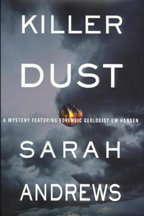 |
Killer Dust,
by Sarah Andrews.
St. Martin’s Minotaur, 2003. ISBN 0 312 30196 0. Hardcover, $24.95.
Geologist Sarah Andrews’ latest venture into the world of fiction is the
newest in a series of eight detective stories following forensic geologist Em
Hansen, who this time takes on a deadly cloud of dust that threatens national
security. Plausible? Perhaps — she begins the novel with a disclaimer:
While the scientific investigations are based on factual efforts, the characters
and storyline are her own inventions, not based on her geologist sources. If
the fascinating field of forensic geology isn’t enough for you, maybe the
side story of the relationship between the heroine and her FBI-agent boyfriend
who is also investigating the sinister dust will keep you absorbed. |
Back to top
Books
for western travelers
These four books cover a large chunk of the landscape of the western United States
at scales ranging from city to state to region. They should interest geologists
living in the West, those planning a trip out West or those looking for an armchair
journey.
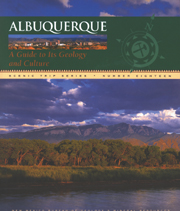 Albuquerque:
A Guide to Its Geology and Culture, by Paul Bauer, Richard P. Lozinsky,
Carol J. Condie, L. Greer Price
Albuquerque:
A Guide to Its Geology and Culture, by Paul Bauer, Richard P. Lozinsky,
Carol J. Condie, L. Greer Price
New Mexico Bureau of Geology and Mineral Resources, 2003. ISBN 1 883905 14 1.
Paperback, $14.95.
Anyone planning a trip to central New Mexico should consider the latest scenic
guide put out by New Mexico’s state geological survey. The 18th in a series
that began 50 years ago, this newest installment has the look and feel of a
trade-press guidebook, full of beautiful photographs and colorful diagrams.
In addition to road logs for six car trips (and one by tram to the crest of
the Sandia Mountains), this highly accessible book includes chapters introducing
geology to the layperson and reviewing the area’s geologic history as well
as chapters on water resource use in the Albuquerque basin and human settlement
of the region.
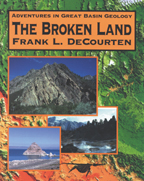 The
Broken Land: Adventures in Great Basin Geology, by Frank L. DeCourten.
The
Broken Land: Adventures in Great Basin Geology, by Frank L. DeCourten.
University of Utah Press, 2003. ISBN 0 87480 751 4. Paperback, $29.95.
The romance of field geology and wide open spaces suffuses DeCourten’s
examination of this desert landscape that covers nearly all of Nevada, a sizeable
hunk of Utah and parts of several neighboring states. Although written for the
layperson, the level of detailed discussion of the geology and paleontology
of the region may challenge the attention span of the casual reader, but make
the book a strong candidate for use as supplementary material in the geology
classroom. Black and white photographs and illustrations are well-chosen and
informative.
 In
Search of Ancient Oregon: A Geological and Natural History, by Ellen
Morris Bishop.
In
Search of Ancient Oregon: A Geological and Natural History, by Ellen
Morris Bishop.
Timber Press, 2003. ISBN 0 88192 590 X. Hardback, $39.95.
Unlike the other books in this section, In Search of Ancient Oregon relies
almost exclusively on photographs to help tell the story. And what photographs
they are! The text provides a narrative of the state’s Phanerozoic history
with a particular emphasis on paleoclimate and paleolandscapes. The stunning
images (taken by the author using a large-format camera) achieve Bishop’s
goal of bringing “long-vanished landscapes to life.” From the coast
to the Cascade volcanoes and the Columbia River gorge to the eastern desert,
you will never see Oregon the same way again.
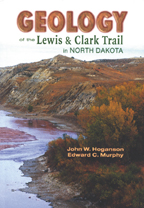 Geology
of the Lewis & Clark Trail in North Dakota, by John W. Hoganson
and Edward C. Murphy.
Geology
of the Lewis & Clark Trail in North Dakota, by John W. Hoganson
and Edward C. Murphy.
Mountain Press Publishing Company, 2003.
ISBN 0 87842 476 8. Paperback, $18.00.
In this bicentennial year of Lewis and Clark’s historic expedition, numerous
books, maps and television specials have covered their journey. But this book
provides a new perspective: a look at the geological wonders that the explorers
witnessed along the way. Armed with a wealth of modern geologic knowledge, a
geologist and a paleontologist set out down Lewis and Clark’s trail. The
authors detail the geologic context behind the sights the explorers noted (such
as burning coal veins and petrified trees), and provide some subsequent finds
(dinosaur fossils and glacial channels) in the Missouri River valley. They also
provide an excellent regional guide, should you find yourself traveling through
the northern plains. Equal parts history book, geology text and travelogue,
this well-written book is chock full of photographs and maps, engaging to any
reader.
Back to top
Maps
New
Maps from the U.S. Geological Survey
MF-2327-C.
NEVADA. Geochemistry, geochronology, mineralogy, and geology suggest
sources of and controls on mineral systems in the southern Toquima Range, Nye
County, Nevada, by D.R. Shawe and J.D. Hoffman, with a section on Lead
associations, mineralogy and paragenesis, and isotopes, by D.R. Shawe, B.R.
Doe, E.E. Foord, H.J. Stein, and R.A. Ayuso. 2003. Four color sheets and one
black and white sheet with 65-page text.
| Sheet 1 (Maps showing the distribution and abundance of gold, silver,
mercury, arsenic, and antimony), color, scale 1:48,000, 88 X 54 inches.
Sheet 2 (Maps showing the distribution and abundance of zinc, copper,
lead, molybdenum, and bismuth), color, scale 1:48,000, 88 X 54 inches. Sheet
3 (Maps showing the distribution and abundance of titanium, vanadium,
and cobalt), color, scale 1:48,000, 66 X 54 inches. Sheet 4 (Maps
showing the distribution and abundance of beryllium, boron, fluorine and
sulfur), color, scale 1:48,000, 66 X 54 inches. Sheet 5 (Maps showing
the locations of rock samples), black and white, scale 1:24,000, 66 X 54
inches. |
Available for $20.00 per sheet from USGS Information Services or free at pubs.usgs.gov/mf/2003/mf-2327-c/.
MF-2381-A.
NEVADA and CALIFORNIA. Geologic map of the Death Valley ground-water
model area, Nevada and California, by J.B. Workman, C.M. Menges, W.R. Page,
E.M. Taylor, E.B. Ekren, P.D. Rowley, G.L. Dixon, R.A. Thompson, and L.A. Wright.
2002. Scale 1:250,000. Two color sheets with 46-page text. Sheet 1, 46 X 63
inches. Sheet 2, 26 X 36 inches. Available for $20.00 per sheet from USGS Information
Services or free at pubs.usgs.gov/mf/2002/mf-2381/.
MF-2412.
ARKANSAS. Geologic map of the Ponca quadrangle, Newton, Boone, and Carroll
Counties, Arkansas, by M.R. Hudson and K.E. Murray. Scale 1:24,000. One
color sheet, 50 X 39 inches. Available for $20.00 from USGS Information Services
or free at pubs.usgs.gov/mf/2003/mf-2412/.
I-2765.
IDAHO. Geologic map of the Salmon National Forest and vicinity, east-central
Idaho, by K.V. Evans and G.N. Green. 2003. Scale 1:100,000. Two color sheets
with 19-page text. Sheet 1, 41 X 58 inches. Sheet 2, 34.5 X 58 inches. Available
for $14.00 from USGS Information Services or free at pubs.usgs.gov/imap/2003/i-2765/.
I-2789. EASTERN and CENTRAL U.S. Map of surficial deposits and materials
in the eastern and central United States (east of 102 degrees west longitude),
by D.S. Fullerton, C.A. Bush, and J.N. Pennell. 2003. Scale 1:2,500,000. One
color sheet 51 X 47 inches with 46-page text. Available for $7.00 from USGS
Information Services.
To order USGS maps: contact USGS Information Services, P.O. Box 25286, Denver,
Colo. 80225. Phone: 888-ASK-USGS (888/275-8747).
Randall Orndorff compiles
the Maps section and is the Associate Program Coordinator for the USGS National
Cooperative Geologic Mapping Program. Email: rorndorf@usgs.gov.
Back to top








 Albuquerque:
A Guide to Its Geology and Culture, by Paul Bauer, Richard P. Lozinsky,
Carol J. Condie, L. Greer Price
Albuquerque:
A Guide to Its Geology and Culture, by Paul Bauer, Richard P. Lozinsky,
Carol J. Condie, L. Greer Price The
Broken Land: Adventures in Great Basin Geology, by Frank L. DeCourten.
The
Broken Land: Adventures in Great Basin Geology, by Frank L. DeCourten. In
Search of Ancient Oregon: A Geological and Natural History, by Ellen
Morris Bishop.
In
Search of Ancient Oregon: A Geological and Natural History, by Ellen
Morris Bishop. Geology
of the Lewis & Clark Trail in North Dakota, by John W. Hoganson
and Edward C. Murphy.
Geology
of the Lewis & Clark Trail in North Dakota, by John W. Hoganson
and Edward C. Murphy.